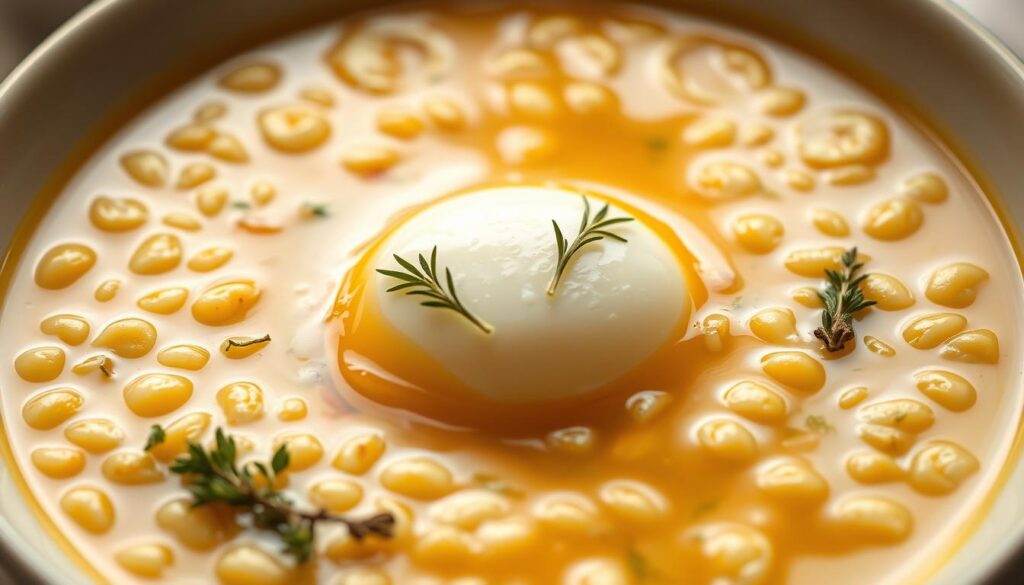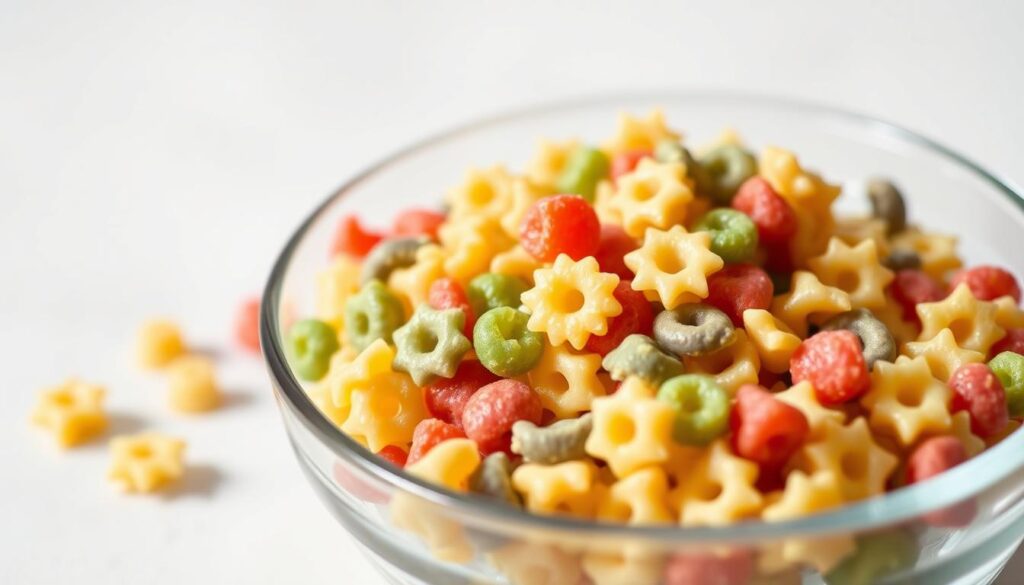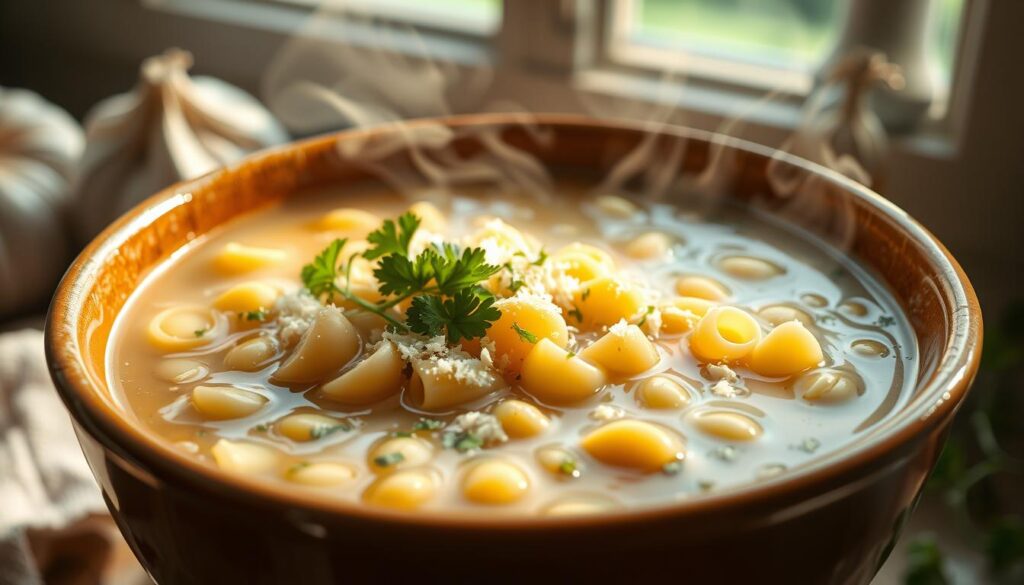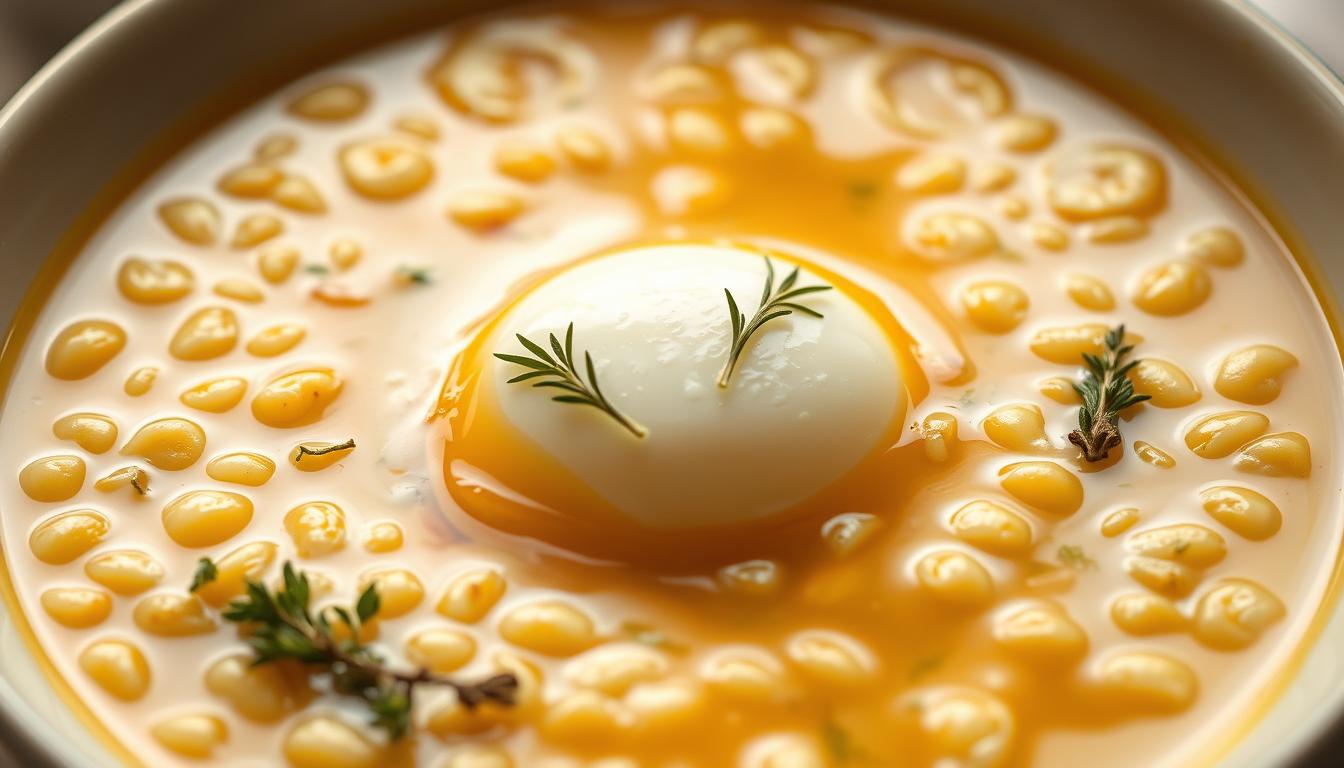
Growing up in an Italian-American kitchen, I learned that pastina soup was more than just a meal. It was a healing ritual. Whenever someone in our family felt sick, my grandmother would quickly start cooking. She made what we called “Italian penicillin soup” from simple ingredients.
This tiny pasta soup was not just food; it was liquid comfort. It was a warm hug that could make any illness go away.
The magic of pastina soup is in its simplicity. Each spoonful carries generations of cooking wisdom. It turns basic ingredients into a nourishing remedy. Whether you’re fighting a cold or just need comfort, this traditional Italian dish offers warmth and wellness.
In this guide, you’ll learn the secrets of making the perfect pastina soup with egg. This dish has comforted Italian families for years. We’ll explore why this tiny pasta soup is more than just a meal.
Key Takeaways
- Pastina soup is a traditional Italian comfort food with healing properties
- The soup takes only 45 minutes to prepare from start to finish
- Each serving provides essential nutrients and only 165 calories
- The dish is popular for children and those feeling unwell
- Eggs add richness and silkiness to the traditional pastina soup
Table of Contents
What is Pastina: Understanding Italy’s Tiniest Pasta
Explore the world of pastina, the smallest pasta that has won the hearts of many. It’s more than a tasty dish; it’s a comfort food with deep roots in Italian culture, loved by generations.

Pastina is the smallest pasta, made from wheat flour and water. It’s about 2 millimeters in diameter. These tiny shapes have been a favorite in Italian kitchens for over 800 years.
Origins and Traditional Uses
Italian families have cherished pastina for its versatility. It’s used in many ways:
- First solid food for babies
- Comfort food for the sick
- Quick meal option for all ages
- Essential ingredient in italian sick soup
Different Types of Pastina Shapes
Pastina comes in a variety of shapes, each adding a special texture to your pastina recipe:
- Stelline (tiny stars)
- Acini di Pepe (small spheres)
- Ditalini Rigate (small tubes)
- Orzo (rice-like shape)
Why It’s Called Italian Penicillin
Pastina is called “Italian Penicillin” because it’s so good for you when you’re sick. A warm bowl of pastina soup is the perfect comfort, providing gentle nutrition and warmth that seems to cure all.
Looking for a taste of Italy or a comforting meal? Pastina connects you to traditional Italian cooking, loved by many for generations.
The Healing Powers of Traditional Pastina Soup

Feeling sick? Nothing beats a warm bowl of italian penicillin soup. This comfort food has been healing Italian families for years. It does more than just fill your belly.
This soup is more than a meal; it’s a trusted remedy. It brings both physical and emotional comfort. Doctors agree, with 80% of broths showing they can help with colds.
- Provides essential nutrients during illness
- Offers psychological comfort and warmth
- Easy to digest when appetite is low
- Helps hydrate and replenish electrolytes
The soup’s nutritional value is impressive. A single serving gives you:
| Nutrient | Amount |
|---|---|
| Calories | 181 kcal |
| Protein | 6 g |
| Carbohydrates | 38 g |
It’s not just about the food. 90% of parents make this soup with love. It’s the care and love in every spoonful that makes it special.
“A bowl of pastina can mend a broken heart and bring a smile during tough times” – Italian Grandmother Wisdom
Essential Ingredients for Perfect Pastina Soup with Egg
Making a great pastina soup starts with picking the right ingredients. Learning how to make pastina means knowing the key parts. These parts turn simple ingredients into a warm, comforting dish.
Choosing the Right Pastina
Choosing the right pastina is key for a great soup. Look for small pasta shapes like:
- Acini di pepe
- Stars
- Alphabets
- Traditional round pastina
Stock Options and Alternatives
The broth is the base of your pastina soup. For a true pastina recipe, try these broths:
- Homemade chicken broth: 8 cups of low-sodium stock
- Store-bought broth
- Vegetable broth for vegetarian versions
The Role of Eggs and Cheese
Eggs and cheese make your pastina soup special. When making pastina, add these:
- Whole eggs for richness
- Parmesan cheese (1 parmesan rind, about 2 inches)
- Pecorino Romano for extra flavor
Pro tip: Whisk eggs into the hot broth for a creamy, luxurious texture. This is what makes traditional Italian comfort food.
Step-by-Step Cooking Instructions
Learning to make pastina is a journey into authentic Italian comfort food. This simple recipe brings warmth and nostalgia to your kitchen in just a few steps.
To start your pastina recipe, gather these key ingredients:
- 4 cups chicken stock
- ½ cup pastina pasta
- 2 tablespoons butter
- Grated Parmigiano cheese
- Salt to taste
Follow these steps to make the perfect pastina soup:
- Bring chicken stock to a rolling boil in a medium pot.
- Add pastina and stir continuously.
- Reduce heat to low-medium.
- Add butter and keep stirring.
- Cook until pastina absorbs 80% of the liquid (about 9-11 minutes).
- Remove from heat.
- Season with salt.
- Stir in grated cheese.
Pro tip: Watch your pastina closely to prevent overcooking, as it can quickly become mushy. The goal is a creamy, tender texture that melts in your mouth.
Finish by sprinkling extra cheese and drizzling a touch of extra virgin olive oil. This adds an authentic Italian touch to your homemade pastina recipe.
Making the Perfect Broth Base
Making a great pastina soup starts with a rich, flavorful broth. This broth is the foundation of your soup. It can turn a simple dish into a cozy meal. Whether you’re learning to make pastina or improving your skills, the broth is essential for a delicious soup.
Your pastina soup needs a great base for depth and warmth. The right broth can make this simple dish unforgettable.
Homemade vs Store-Bought Stock
When making pastina soup, you have two main broth choices:
- Homemade Stock: Gives you the most flavor and lets you control what goes in
- Store-Bought Broth: Is easy to find and doesn’t skimp on taste
For homemade stock, use 4 cups of chicken bone broth. Here’s what you should add:
| Ingredient | Quantity |
|---|---|
| Chicken Bone Broth | 4 cups |
| Protein Content | 10 grams per cup |
Adding Aromatics and Vegetables
Boost your pastina soup’s taste by adding aromatic veggies. A good mix includes:
- 3 minced garlic cloves
- 2 chopped carrots
- 5-8 thyme sprigs
- 1/4 cup olive oil
When cooking pastina, stir often and cook for 5-6 minutes. This way, your homemade pastina soup will be both healthy and comforting.
How to Add Egg to Pastina Soup
Adding an egg to your pastina recipe makes it creamy and nutritious. It turns a simple dish into a comforting meal. The trick is to add the egg carefully to avoid scrambling and get a smooth texture.
Here’s the perfect method for adding egg to your pastina with egg soup:
- Whisk the egg in a separate small bowl
- Temper the egg by slowly adding hot pastina broth, one tablespoon at a time
- Gradually pour the tempered egg mixture into the simmering soup
- Stir continuously on low heat to maintain a creamy consistency
For the most luxurious pastina recipe, consider these egg variations:
- Whole egg: Adds protein and creates a richer broth
- Egg yolk only: Delivers an extra-creamy texture
- Beaten egg: Distributes evenly throughout the soup
Professional chefs say to use fresh, room-temperature eggs for the best results. The secret is to keep the heat low. This way, the egg won’t scramble and your soup will be velvety smooth. It will warm your body and soul.
Pastina Soup Variations and Add-ins
Explore the many ways to enjoy pastina soup. These variations turn a simple soup into a flavorful journey. They add nutrition and make meals more satisfying.
Pastina soup is perfect for personalizing your meals. Each twist brings new tastes and health benefits. It makes this Italian dish even more comforting.
Secret Veggie Version
Make your pastina soup healthier with vegetables. Here’s how to add more veggies:
- Choose 3-4 veggies like carrots, celery, cauliflower, and onions
- Simmer them in chicken stock until they’re soft
- Blend them with the stock until smooth
- Use this veggie stock as your soup base
- Cook pastina in this tasty liquid
Chicken Pastina Variation
Turn your pastina into a protein-packed meal with chicken. A 5.5 lb whole chicken makes a big, flavorful soup for 8-10 people.
- Roast the chicken at 350°F for about 1 hour and 15 minutes
- Shred the chicken and add it to your soup
- Add diced carrots, celery, and leeks for more taste
- Season with fresh thyme and minced garlic
Brothy No-Egg Option
For a lighter pastina, try this brothy version. It’s gentle and comforting, great for sensitive stomachs or a less creamy soup.
- Use 8 cups of chicken stock or bone broth
- Cook 8 oz of gluten-free stelline pasta
- Add a squeeze of lemon juice for a fresh taste
- Garnish with fresh parmesan cheese
Each version has about 263 calories per serving. It has 43g of carbs and 11g of protein. Try them out and find your favorite!
Tips for Achieving the Perfect Consistency
Learning how to make pastina is all about paying attention to detail. The key is getting the soup just right. With some expert tips, you’ll make a perfect pastina recipe every time.
Here are some important tips for your pastina recipe:
- Stir frequently to prevent sticking to the pot bottom
- Use a timer to avoid overcooking
- Maintain a low to medium heat setting
- Add warm broth gradually to control thickness
The secret to perfect pastina is in the liquid ratios. Start with slightly less liquid than you think you’ll need. If it gets too thick, just add more warm broth or water. Most people stir every minute to cook evenly and avoid clumps.
When making pastina for one, watch your pot size closely. A small amount can quickly become too thick or dry. To keep your soup light and brothy, try:
- Using 4-6 cups of broth per cup of pastina
- Removing from heat just before the pasta reaches full tenderness
- Letting the residual heat finish the cooking process
Pro tip: If your soup gets too thick, just whisk in some warm broth. You want a silky texture that’s not too watery or too thick.
Health Benefits and Nutritional Value
Italian penicillin soup, also known as pastina soup, is more than a comfort food. It’s a nutritional powerhouse. This beloved dish offers warmth and nostalgia, plus essential nutrients.
A single serving of pastina soup has impressive nutritional benefits:
- Total calories: 284.7 kcal
- Protein: 9 g
- Carbohydrates: 61.4 g
- Fiber: 4.3 g
The ingredients in this traditional soup offer significant health advantages. Garlic, a key component, contains allicin sativum. This compound has antiviral and antimicrobial effects. Carrots add cRG-I, a fiber that boosts immune responsiveness. Ginger has anti-inflammatory properties and helps with digestive issues.
When you’re feeling sick, pastina soup can help. Its easy-to-digest pasta and nutrient-rich broth are perfect for recovery. The mix of vegetables and protein supports your immune system and provides gentle nourishment.
To boost your soup’s nutritional value, add extra veggies or use whole grain pastina. This versatile Italian penicillin soup can be a regular part of a balanced diet. It offers comfort and health in every spoonful.
Serving Suggestions and Pairings
Your pastina soup needs the perfect side to make it even better. This Italian sick soup is more than food—it connects you to your family’s past. It’s perfect for warming up on a cold day or when you’re feeling under the weather.
Traditional Italian Accompaniments
Italians know how to pair food simply yet beautifully. A slice of homemade bread is great for dipping in your soup. Add a light garden salad with Boston lettuce and roasted red onions for a nice contrast. A sprinkle of fresh Parmesan cheese adds depth and authenticity.
Modern Serving Ideas
Make your pastina soup more filling by adding grilled chicken or roasted veggies. Try a butternut squash Panzanella salad for a fun twist. Serve it in your favorite bowl, with a blanket and soft music for a cozy meal.
Remember, pastina soup is a warm hug in a bowl. Try different ways to serve it to feel nourished and loved. You can stick to traditional ways or add your own modern touch.


2 thoughts on “Pastina soup with egg”